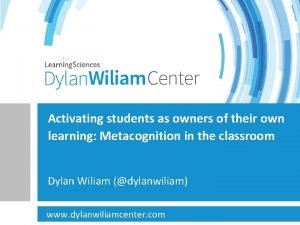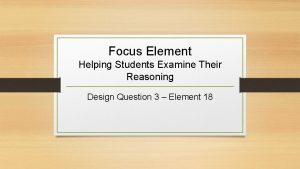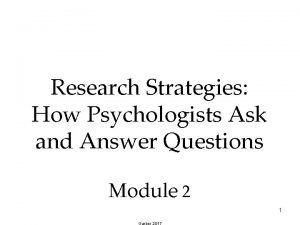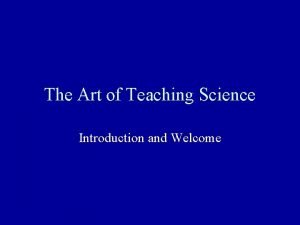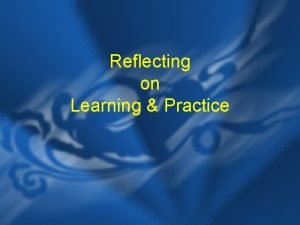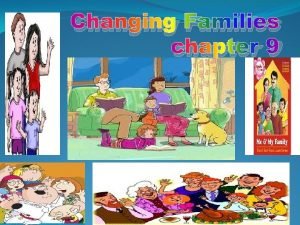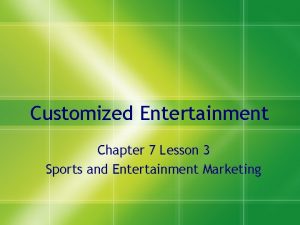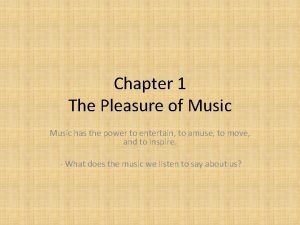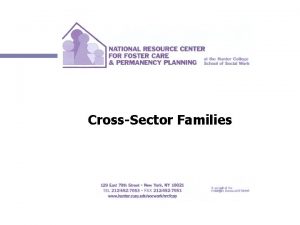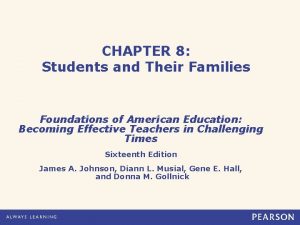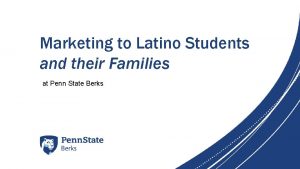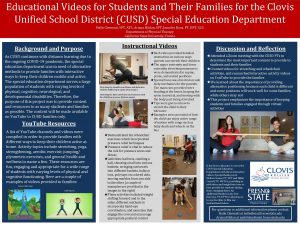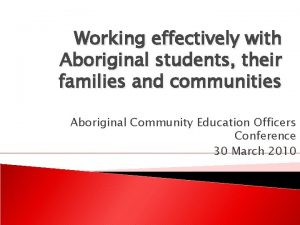Students and Their Families Chapter 8 Summary Makayla


























- Slides: 26

Students and Their Families Chapter 8 Summary Makayla Davis, Ariana Weaver, and Daija Gahagan TLED 315 Fall 2019 Professor Greene Old Dominion University

1950 vs Now Today’s Families What do Families look like? Statistics ● ● ● “ 7 in 10 children under 18 years old live with 2 parents” “ 1 in 4 U. S. children live with one of his or her parents” “½ of African American children live in custodial-parent families in which one of the parents does not live with his or her children” Student Interactions

Parenting Parents and caretakers have a big influence on learning in the years leading up to a child starting school. ● Reading to children and limiting TV time ● Larger vocabularies ● Access to resources Teachers and parents need to work together. Parental participation and communication are important.

Economic Stress 7 in 10 parents and 65 percent of students worry about finances. Effects of Limited Family Income ● Homelessness ○ ○ Causes Children Youth Homelessness and school ● Federal Programs for Students from Low-Income Families ○ ○ ○ Title 1 Head Start Free or Reduced-Price Lunch

Children Left Alone After School Children of all ages are left in the care of others in the hours after school ● ● Parents or relatives By themselves Center-based programs Extracurricular programs Children who are left by themselves are ● ● at a greater risk for injuries more likely to have behavior problems, lower social competence, and poorer academic performance ● more likely to experiment with drugs, alcohol, and sex.

Dangers Children & Youth Face Where is the danger found? ● Recognize the signs ● Know when to intervene ● Provide support

Child Abuse ● 3. 9 million referrals in the year 2014 ● 3 of 4 victims of child abuse suffer from neglect ● 1 in 4 U. S. children experience some type of abuse before they’re 18 Signs to look for: ○ Bruises, Burns, Broken bones, Depression, Withdrawal, Extreme thinness, Nervousness ALWAYS file a report if abuse is suspected Teachers and other staff may be the only support a child receives

Sexual Harassment in Schools Nearly ½ of middle and high school students report they have been sexually harassed at school Most likely to be a victim of Sexual Harassment ● ● ● Girls LGBTQ Low-income students How do students respond? What can we do?

Bullying in Schools Bullying: ● ● ● Physical Verbal Relational/Social Victims are at risk of having “high risks of emotional stress, depression, anxiety, sleep problems, and poor school adjustment” Technology brought us to a new form of bullying, cyberbullying. Teachers should model behaviors and intervene when bullying is witnessed.

Suicide ● Third leading cause of death in adolescents ● Gay teens are 2 to 3 times more likely to attempt to commit suicide. ● Often a cry for help ● Warning signs: ○ Mood changes ○ Changes in sleeping patterns ○ Anxiety ○ Withdrawal

Challenges of the Teen Years Ranging from sexuality and pregnancy, substance abuse and economic realities, the challenges of teen years can be quite an experience for many young people.

Sexuality and Pregnancy ● Teenagers begin defining their sexuality through identity and attraction ● Many teenagers are taught to associate sex with freedom and adulthood ○ ○ Uncertainty fueled by mixed messages sent via older friends, parents and teachers Teenage pregnancy is down and on average only ⅓ of high schoolers are sexually active ● Challenge for parents and educators to encourage young people to make positive choices ○ Adults usually regard teenagers as too young to deserve the benefits of adulthood ● Many students in bigger cities believe that the media views them, as a whole, negatively ○ Validated in the form of cut spending in schools ● Respect from adults is critical for youth to form a healthy self esteem.

Substance Abuse ● Associated with adult behavior ● Can be associated with biological predispositions or psychological problems that trigger the substance abuse ○ Social pressures, family problems and self hate are other reasons teens turn to substances ● Can lead to chemical dependency which requires medical treatment ● Large percentage of teenagers experiment with drugs/alcohol ○ ○ ⅔ high schoolers have experimented with alcohol ⅖ high schoolers have tried marijuana ● Substance abuse is an an all-time-low for teenagers(excluding marijuana) according to a 2015 study ● Licit and illicit drugs use to be more commonly used amongst white students but now african american and hispanic students are using marijuana at higher rates

Economic Realities ● Majority of young people are worried about their economic futures ○ Many continue to still seek out post-secondary education ● 66% of high schoolers go to college directly out of high school ○ Varies by race and socioeconomic status ● Females make up 59% of the students enrolled in college in 2013 ● ⅕ teens have jobs in 2014 ○ Teens working summer jobs has also increased by over half of 16 -24 y/o students have summer jobs ● After-school jobs can be extremely beneficial as many students can develop a healthy ● ● sense of responsibility and be rewarded by it monetarily Students from more economically disadvantaged households who work are less likely to drop out However, students grades can suffer if they do not develop good time management

Equity in Schools Many persons of color, limited english speakers, women, persons with disabilities, people on low income, people affiliated with religions other than christianity and members of the LGBTQ+ are considered minorities and are continually discriminated against.

Prejudice ● Construction of self ○ Though identification and affiliation to their sex, gender, racial/ethnic group ● Prejudice: a preconceived negative attitude toward members of a specific ethnic, racial, religious or socioeconomic group ● Prejudice attitudes can be transformed into discriminatory behavior ● Socialization is the process of learning the social norms of one's culture ● Prejudice is often reinforced by the school systems that have a disproportionate amount of low income or ethnically diverse students ● You can take steps to prevent your prejudice from impacting your students ○ ○ Be conscious of your interactions with your students Have a colleague watch your interactions with students and make suggestions

The Impact of Discrimination ● Discrimination: The process that prevents members of a specific group from participating equally in society. ○ Students of color, woman, low income students, students with disabilities and LGBTQ+ students ● Zero tolerance policies: strict enforcement of school rules to even minor infringements w/o exceptions ○ ○ Schools are beginning to abandon these policies because an overwhelming amount of students who fall victim to these policies are minorities and it ends up removing them from school Removing students from school will likely cause them to end up in more trouble

Differing Perspectives: Should Out-of-School Student Suspensions Be Limited? YES ● ● ● NO Loss of time in the learning environment negatively affects the academic learning of several million children High suspension correlates with higher dropout rates Students who are suspended from school are more likely to end up in future trouble ○ ● ● School-to-prison pipeline Minorities have a disproportionately high suspension rate ○ ● Civil rights and social justice issue ● Suspension of students who are breaking the rules is essential to maintaining discipline Ensures safety of all students Threat of suspension deters students from being subordinate In-school detention is not effective in many cases Nonpunitive approaches allow disruptive students to remain in the classroom often preventing others from learning What is your perspective on this issue?

Racism ● Racism: The conscious or unconscious belief that racial differences make one group superior to the others ○ Systematically ● Educators MUST acknowledge how racism has benefited some groups because it gave them advantages over others ○ Black Lives Matter is forcing all of us to face the racism that exists in not only our police departments but also our schools ● Parents often distrust educators because of their history of discrimination in society and schools ● As educator we must acknowledge and confront school policies we feel are racist. ● When parents believe that we care about their children's academic and social achievement they are more likely to trust us

Engagement in School With all of the outside concerns that students face, sometimes education can lose its sense of importance. This can be as a result of low academic performance, or be attributed to nonacademic circumstances both in and outside of the classroom.

Leaving School Early ● Dropping out of school is most common in urban schools ● African American, American Indian, and Hispanic students continue to lag behind their Asian American and White peers in high school graduation rates ● Students from low income families are more likely to be high school dropouts than students from middle and high income families ● Female students are more likely to graduate high school than male students ● Slightly more than half of students with disabilities complete high school ○ What effect does this have? ● Student engagement is especially critical in middle school & ninth grade ● Initiatives to decrease high school dropout rates include the Grad. Nation Campaign and Civic Marshall Plan

Resiliency ● The economic and social struggles addressed earlier in the chapter can place students at risk for challenges in the classroom related to development, behavior, and academics ● Some students can overcome these difficulties and are able to push beyond stereotypes, preconceived notions, biases, and other criticisms designed to hold them back ● These students are resilient and rely on their self-efficacy to motivate them ● Children whose family members make an effort to be active in their lives are more likely to be resilient ● Resilient children are also likely to have positive relationships with teachers

Access to Technology ● Students have been proven to be more engaged in an activity when it is relative to something of importance to them ● In an effort to maintain engagement in the classroom, technology has been implemented to provide a tool with which students are familiar ● This is a problem for students whose families cannot afford to equip them with the latest in technological advances ● Teachers and students can use technology in a variety of ways to diversify the learning experience ● Students without Internet access are at a disadvantage

Parent Involvement It is imperative to make parents feel included in the academic progress of their children. Research shows that collaborative effort between teachers and parents has a positive effect on students’ achievement.

Communicating with Families ● Consistent communication between educators and families allows for greater chances of student success ● It is important to be thorough in communicating all aspects of a child’s learning experience with their family ● Technology is being used more than ever to make parent/teacher communication convenient ● It is of specific importance to keep in contact with parents of students of disabilities

Engaging Families ● Family background plays a role in how engaged parents of students appear ● Teachers have a responsibility to learn about the community that they teach in ● Parents and teachers have to work together to ensure the best outcome for children ● Both teachers and parents agree that there is room for improvement in the joint effort to educate children
 Makayla nichols
Makayla nichols Call makayla
Call makayla Daniel twigg
Daniel twigg Big families vs small families
Big families vs small families Characteristics of logic
Characteristics of logic Champion of filipino students rizal
Champion of filipino students rizal Chapter 9. voices and instrument families
Chapter 9. voices and instrument families Marzano helping students examine their reasoning
Marzano helping students examine their reasoning Activating students as owners of their own learning
Activating students as owners of their own learning Helping students examine their reasoning
Helping students examine their reasoning Obey teachers
Obey teachers Not only the students but also the instructor
Not only the students but also the instructor Students from a journalism class ask only their friends
Students from a journalism class ask only their friends Students reflection on their learning sample
Students reflection on their learning sample Students reflection on their learning sample
Students reflection on their learning sample Their eyes were watching god chapter 19-20 summary
Their eyes were watching god chapter 19-20 summary Their eyes were watching god chapter 1 summary
Their eyes were watching god chapter 1 summary Their eyes were watching god hezekiah
Their eyes were watching god hezekiah Chapter 10 their eyes are watching god
Chapter 10 their eyes are watching god Their eyes were watching god summary chapter 6
Their eyes were watching god summary chapter 6 Their eyes were watching god chapter 13 quotes
Their eyes were watching god chapter 13 quotes Their eyes were watching god summary
Their eyes were watching god summary Tewwg chapter 4
Tewwg chapter 4 How does hurston weave folklore into this chapter
How does hurston weave folklore into this chapter Changing families
Changing families Chapter 7 lesson 3 help for families
Chapter 7 lesson 3 help for families Compare and contrast the bach and marsalis families
Compare and contrast the bach and marsalis families








